
The 4th Indian Infantry Division, also known as the Red Eagle Division, is an infantry division of the Indian Army. This division of the British Indian Army was formed in Egypt in 1939 during the Second World War. During the Second World War, it took part in campaigns in East Africa, Syria, North Africa and Italy. Post independence, the division is part of the I Corps and headquartered at Prayagraj.
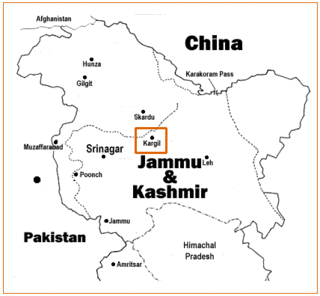
The Kargil War, also known as the Kargil conflict, was fought between India and Pakistan from May to July 1999 in the Kargil district of Jammu and Kashmir and elsewhere along the Line of Control (LoC). In India, the conflict is also referred to as Operation Vijay, which was the codename of the Indian military operation in the region. The Indian Air Force acted jointly with the Indian Army to flush out the Pakistan Army and paramilitary troops from vacated Indian positions along the LoC, in what was designated as Operation Safed Sagar.
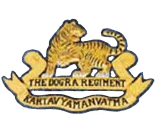
The Dogra Regiment is an infantry regiment of the Indian Army. The regiment traces its roots directly from the 17th Dogra Regiment of the British Indian Army. When transferred to the Indian Army like its sister regiments, the numeral prefix was removed. Units of the Dogra Regiment have fought in all conflicts that independent India has been engaged in, making it one of the most prestigious and most decorated regiments of the Indian Army.
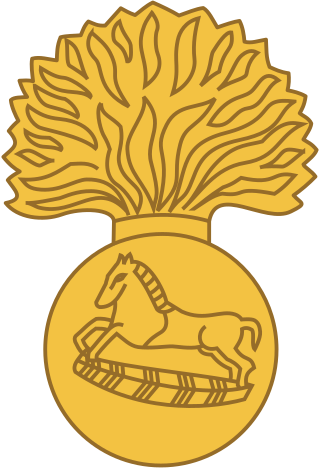
The Grenadiers is an infantry regiment of the Indian Army, formerly part of the Bombay Army and later the pre-independence British Indian Army, when the regiment was known as the 4th Bombay Grenadiers. It has distinguished itself during the two world wars and also since the Independence of India. The regiment has won many battle honours and gallantry awards, and is considered to be one of India's most decorated regiments with three Param Vir Chakra awardees in three different conflicts.
The Battle of Tololing was a pivotal battle in the Kargil War between India's 2nd Rajputana Rifles's and troops from one full battalion of Pakistan’s Northern Light Infantry who were aided by Pakistani irregulars in 1999.
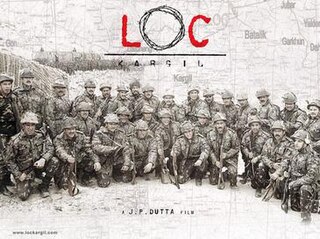
LOC Kargil is a 2003 Indian Hindi-language historical war film based on the Kargil War fought between India and Pakistan, produced and directed by J. P. Dutta under his banner "J. P. Films". The film features an ensemble cast of Bollywood stars and music composed by Aadesh Shrivastava and Anu Malik, with the former composing the score and the latter composing the songs.
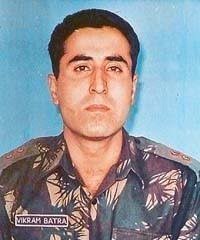
Vikram Batra was an Indian Army officer. He was posthumously awarded the Param Vir Chakra, the highest Indian military decoration, for his actions during the Kargil War; on 7 July 1999, Batra was killed while fighting Pakistani troops around Area Ledge, Point 4875, in the Kargil district of erstwhile Jammu and Kashmir.
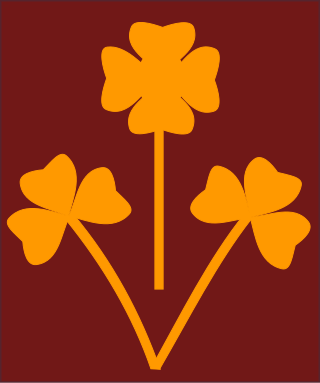
The 8th Mountain Division was raised as the 7th Indian Infantry division of the British Indian Army. It is now part of the Indian Army and specialises in mountain warfare.
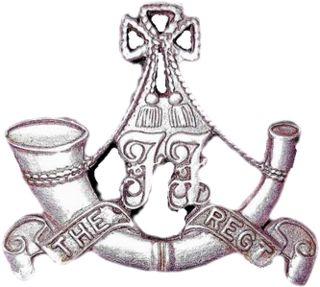
The Frontier Force Regiment is one of the six infantry regiments of the Pakistan Army. They are popularly known as the Piffers in reference to their military history as the PIF of the British Indian Army, or as the FF. The regiment takes its name from the historic North-West Frontier, a former province of British India and later Pakistan.

Captain Anuj Nayyar, MVC was an Indian Army officer of 17 Jat who was posthumously awarded the Maha Vir Chakra, India's second highest gallantry award, for exemplary valour in combat during operations in the Kargil War in 1999.

The 10th Indian Infantry Division was a war formed infantry division of the Indian Army during World War II. In four years, the division travelled over 4,000 miles (6,400 km) from Tehran to Trieste, fought three small wars, and fought two great campaigns: the Anglo-Iraqi War, the Invasion of Syria–Lebanon, the Anglo-Soviet invasion of Iran, the North African Campaign, and the Italian Campaign.

The Naga Regiment is an infantry regiment of the Indian Army. It is among the youngest regiments of the Indian Army - the first battalion was raised in Ranikhet, Kumaon in 1970. The regiment recruits mainly from Nagaland, in northeast India.
The 11th Indian Infantry Division was an infantry division of the Indian Army during World War II. It formed part of Indian III Corps in the Malaya Command during the Battle of Malaya. The division was re-raised on 1 April 1965 and is presently part of the XII Corps of Southern Command. It is presently responsible for safeguarding the borders with Pakistan along Southern Rajasthan and Gujarat.
Ghatak Platoons are special operations capable reconnaissance platoons present in every infantry battalion of the Indian Army. Ghatak is a Sanskrit word meaning "killer" or "lethal". Their name was given to them by General Bipin Chandra Joshi. They act as shock troops and spearhead assaults ahead of the battalion.
The Battle of Tiger Hill encompasses the battles fought in and around the peak of Tiger Hill between the Indian Army and Pakistan from the final week of May till second week of June 1999, during the Kargil War. The battle, with the concomitant battle for the adjoining peak of Tololing, culminated in Indian forces capturing Tiger Hill. The Tiger Hill area, including Point 5100, is to the west of Tololing. Peaks in Tololing include Point 5140 and Point 4875, etc.

The Kargil War order of battle (KWORBAT), is a deposition and systematic combatant structure of the Indian Army troops and the unified Pakistan Armed Forces combat commands, active in the Kargil region in 1999, during the Kargil War. The Indian Army orbat is based on the publications provided by the Indian military authors, news media and official sources.

The Kargil War Memorial, also known as Dras War Memorial, is a war memorial built by the Indian Army in the town of Dras, near Kargil city in Kargil district of Ladakh, India, commemorating the 1999 Kargil War between India and Pakistan. The memorial is located on the Srinagar-Leh National Highway 1D, about 5 km from the city centre across the Tiger Hill, Kargil.
Point 5353 is a mountain peak on the Line of Control dividing the Indian- and Pakistani-administered portions of Kashmir in the vicinity of Dras in the Kargil district. It is the highest peak along the Marpo La ridge and dominates the entire area on both the sides of the Line of Control.
Colonel Balwan Singh Panghal MVC is a decorated Indian Army officer who was awarded the Maha Vir Chakra for his courage in leading the successful assault to capture Tiger Hill during the 1999 Kargil War.
Yaldor Sub Sector was the scene of some of the major infiltration by Pakistani Northern Light Infantry battalions and some of the major battles of Kargil War were fought here.














